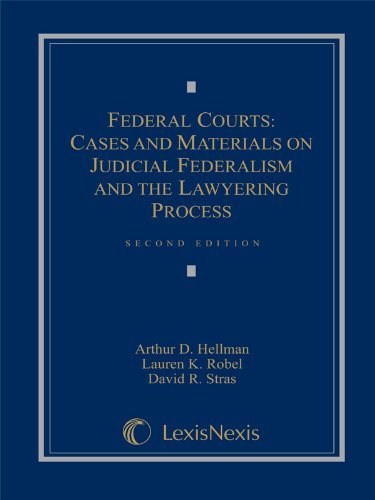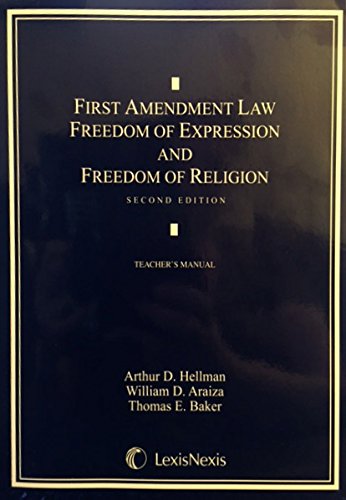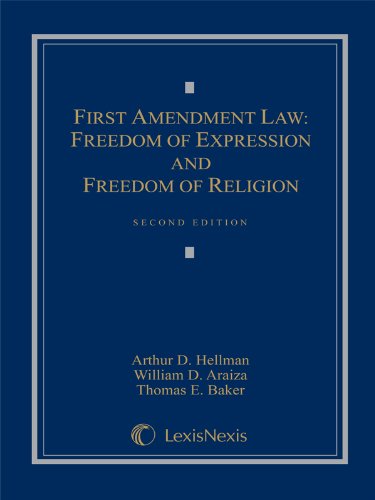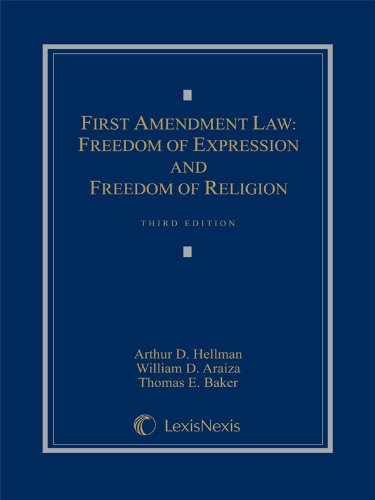Background
Hellman, Arthur David was born on December 9, 1942 in New York City. Son of Charles and Florence (Cohen) Hellman.


(This three-hole punched, alternative loose-leaf version o...)
This three-hole punched, alternative loose-leaf version of the hardbound book is printed on 8 ½ x 11 inch paper with wider margins and the same pagination – offered at a substantially lower price than the hardbound book. This book is the product of the authors' rethinking of what a Federal Courts course can be. Although fully attentive to the deeper theoretical issues of federalism and separation of powers raised by the cases, the book also focuses on giving students the grounding they will need to be effective lawyer-litigators. The book's objective is to provide students with the doctrinal, theoretical, and practical education that will enable them to identify and strategically employ jurisdictional tools to effectively serve their clients in litigation. Two major themes distinguish this book from others on the market: • First, the book gives sustained and systematic attention to the role of state courts as a forum for litigation of federal issues. • Second, the book is grounded in the realities of litigation today -- in particular, the strong tendency of defendants in civil litigation to prefer federal court over state court. The statutory device of removal, and other issues that dominate contemporary litigation, are addressed throughout this book. In addition, the book is organized in a way that reinforces learning and facilitates interstitial reiteration of important points. A modular design enables teachers to select particular aspects of larger topics for made-to-order course coverage. Based on the authors' extensive classroom experience teaching Federal Courts, the book effectively integrates problems as teaching and learning tools. The problems have been carefully designed to require students to identify and apply relevant concepts from the governing law, including the cases in the book, from the perspective of a lawyer seeking to accomplish a particular goal. Many of the problems are based on recent appellate cases that the Supreme Court declined to hear. The book provides thorough coverage of the public law issues that dominate scholarly writings on federal courts, but it is also uniquely geared to preparing students to serve their clients effectively ordinary litigation. This publication is also accompanied by the Judicial Code Supplement. A unique feature of this Supplement is the inclusion of selected provisions of other titles of the United States Code -- not just procedural provisions like the Administrative Procedure Act and the Federal Arbitration Act, but also ERISA, FELA, RICO, and other substantive statutes that bear on the issues treated in a Federal Courts course.
http://www.amazon.com/gp/product/1422472663/?tag=2022091-20

(Teacher's Manual to Student Book: First Amendment Law: Fr...)
Teacher's Manual to Student Book: First Amendment Law: Freedom of Expression and Freedom of Religion - Second Edition.
http://www.amazon.com/gp/product/0327176504/?tag=2022091-20

(This new casebook rests on a straightforward premise: The...)
This new casebook rests on a straightforward premise: The First Amendment can be viewed as history, as policy, and as theory, but from a lawyer's perspective, it is above all law--albeit a special kind of law. One thing that is special is that the governing texts have receded into the background. The law is the cases, and the cases are the law. Close analysis of precedent is therefore the principal tool of argumentation and adjudication. The purpose of this casebook is to help students to learn the law in a way that will enable them to use it in the service of clients. Several features of the book promote this goal. The cases are edited with a relatively light hand. Notes and questions provide guidance in working with the opinions. The structure of the book--closely tracking the structure that the Supreme Court has imposed--helps to reinforce learning. Non-case materials (including drafts and memoranda from the Justices' private papers) are used to shed light on what was established by existing precedents and how a new decision changes (or does not change) the law. By giving primacy to the Justices' won words and the Court's own doctrinal structure, the book offers maximum flexibility for teachers to place their own imprint on the course.
http://www.amazon.com/gp/product/142247030X/?tag=2022091-20

(This book is the product of the authors' rethinking of wh...)
This book is the product of the authors' rethinking of what a Federal Courts course can be. Although fully attentive to the deeper theoretical issues of federalism and separation of powers raised by the cases, the book also focuses on giving students the grounding they will need to be effective lawyer-litigators. The book's objective is to provide students with the doctrinal, theoretical, and practical education that will enable them to identify and strategically employ jurisdictional tools to effectively serve their clients in litigation. Two major themes distinguish this book from others on the market: • First, the book gives sustained and systematic attention to the role of state courts as a forum for litigation of federal issues. • Second, the book is grounded in the realities of litigation today -- in particular, the strong tendency of defendants in civil litigation to prefer federal court over state court. The statutory device of removal, and other issues that dominate contemporary litigation, are addressed throughout this book. In addition, the book is organized in a way that reinforces learning and facilitates interstitial reiteration of important points. A modular design enables teachers to select particular aspects of larger topics for made-to-order course coverage. Based on the authors' extensive classroom experience teaching Federal Courts, the book effectively integrates problems as teaching and learning tools. The problems have been carefully designed to require students to identify and apply relevant concepts from the governing law, including the cases in the book, from the perspective of a lawyer seeking to accomplish a particular goal. Many of the problems are based on recent appellate cases that the Supreme Court declined to hear. The book provides thorough coverage of the public law issues that dominate scholarly writings on federal courts, but it is also uniquely geared to preparing students to serve their clients effectively ordinary litigation. This publication is also accompanied by the Judicial Code Supplement. A unique feature of this Supplement is the inclusion of selected provisions of other titles of the United States Code -- not just procedural provisions like the Administrative Procedure Act and the Federal Arbitration Act, but also ERISA, FELA, RICO, and other substantive statutes that bear on the issues treated in a Federal Courts course.
http://www.amazon.com/gp/product/1422470164/?tag=2022091-20

(The Third Edition of Federal Courts: Cases and Materials ...)
The Third Edition of Federal Courts: Cases and Materials on Judicial Federalism and the Lawyering Process follows the approach of the two previous editions (published in 2005 and 2009). It concentrates on the main lines of doctrinal development and their implications for future disputes rather than attempting an encyclopedic treatment of subsidiary points. It emphasizes elements of litigation strategy and the practical application of doctrine as well as the underlying policy and theoretical issues. Federal Courts: Cases and Materials on Judicial Federalism and the Lawyering Process is the product of the authors' rethinking of what a Federal Courts course can be. Although fully attentive to the deeper theoretical issues of federalism and separation of powers raised by the cases, the book also focuses on giving students the grounding they will need to be effective lawyer-litigators. The objective of the book is to provide students with the doctrinal, theoretical, and practical education that will enable them to identify and strategically employ jurisdictional tools to effectively serve their clients. Two major themes make Federal Courts: Cases and Materials on Judicial Federalism and the Lawyering Process distinctive among Federal Courts casebooks: 1. This book gives sustained and systematic attention to the role of state courts as a forum for litigation of federal issues. 2. This book is grounded in the realities of litigation today -- in particular, the strong tendency of defendants in civil litigation to prefer federal court over state court. The statutory device of removal, and other issues that dominate contemporary litigation, are addressed throughout this book. In addition, Federal Courts: Cases and Materials on Judicial Federalism and the Lawyering Process is organized in a way that facilitates learning and reinforces important points. A modular design enables teachers to select particular aspects of larger topics for made-to-order course coverage. Based on the authors' extensive classroom experience teaching Federal Courts, this book effectively integrates problems as teaching and learning tools. The problems have been carefully designed to require students to identify and apply relevant concepts from the governing law, including the cases in the book, from the perspective of a lawyer seeking to accomplish a particular goal. Many of the problems are based on recent appellate cases. Federal Courts: Cases and Materials on Judicial Federalism and the Lawyering Process provides thorough coverage of the public law issues that dominate scholarly writings on federal courts, but it is also uniquely geared to preparing students to serve their clients effectively in more routine litigation matters. -Significant revisions to the Third Edition include: -Extensive coverage of the important revisions to the law governing removal made by the Federal Courts Jurisdiction and Venue Clarification Act of 2011 (JVCA). -Introduction of aspects of removal jurisdiction not previously covered. -Seven new principal cases on topics ranging from qualified immunity to constitutional limits on non-Article III courts and state-court power to decline to hear federal claims. -New problems on a variety of topics, including justiciability, the Anti-Injunction Act, supervisory liability under §1983, jurisdiction-stripping, and the Rooker-Feldman doctrine. -Reorganization of the materials on the Erie doctrine in light of the Supreme Court decision in Shady Grove.
http://www.amazon.com/gp/product/0769858759/?tag=2022091-20

(This casebook rests on a straightforward premise: The Fir...)
This casebook rests on a straightforward premise: The First Amendment can be viewed as history, as policy, and as theory, but from a lawyer's perspective, it is above all law-albeit a special kind of law. One thing that is special is that the governing texts have receded into the background. The law is the cases, and the cases are the law. Close analysis of precedent is therefore the principal tool of argumentation and adjudication. The purpose of this casebook is to help students to learn the law in a way that will enable them to use it in the service of clients. Several features of the book promote this goal. The cases are edited with a relatively light hand. Notes and questions provide guidance in working with the opinions. The structure of the book-closely tracking the structure that the Supreme Court has imposed-helps to reinforce learning. Non-case materials (including drafts and memoranda from the Justices' private papers) are used to shed light on what was established by existing precedents and how a new decision changes (or does not change) the law. By giving primacy to the Justice' won words and the Court's own doctrinal structure, the book offers maximum flexibility for teachers to place their own imprint on the course. The Third Edition has the following new features: • A new section devoted to the Supreme Court's recent decisions rejecting requests to add to the categories of unprotected speech (US v. Stevens, Brown v. Entertainment Merchants Assn, US v. Alvarez) • A reworked section on campaign finance that presents the relevant information in compact, teachable form • A reworked chapter on the relationships between the two Religion Clauses that gives prominence to the Courts important 2012 decision in Hosanna-Tabor Evangelical Lutheran Church v. EEOC • Compact Note treatment of several older cases with sufficient extracts to permit in-depth class discussion
http://www.amazon.com/gp/product/1630431087/?tag=2022091-20
Hellman, Arthur David was born on December 9, 1942 in New York City. Son of Charles and Florence (Cohen) Hellman.
Bachelor magna cum laude, Harvard University, 1963; Juris Doctor, Yale University, 1966.
Law clerk to, associate justice Minnesota Supreme Court, 1966-1967;
assistant professor, William Mitchell College Law, St. Paul, 1967-1970;
assistant professor, U. Connecticut School Law, West Hartford, 1970-1972;
visiting assistant professor, University of Illinois College Law, Champaign, 1972-1973;
deputy executive director, Commision on Revision Federal Court Appellate System, Washington, 1973-1975;
associate professor, U. Pittsburgh School Law, 1975-1980;
professor, U. Pittsburgh School Law, since 1980. Supervising staff attorney United States Court Appeals (9th circuit), San Francisco, 1977-1979. Visiting associate professor of University Pennsylvania School Law, Philadelphia, fall 1979.
Lecturer judicial conferences, judges' seminars, since 1976. Consultant various law firms, since 1979. Faculty member Practicing Law Institute Program on Federal Appellate Practice, New York City, 1984.
Planner National Conference Empirical Research in Judicial Administration, Tempe, Arizona, 1988. General editor United States Court Appeals 9th Circuit Project Improvements in Judicial Administration, 1987-1991. Principal investigator intercir. conflicts study Federal Judicial Center, 1990.
Faculty member Federal Judicial Center National Workshop for Judges of the United States Court Justices of Appeals, 1993.
(This three-hole punched, alternative loose-leaf version o...)
(This new casebook rests on a straightforward premise: The...)
(This casebook rests on a straightforward premise: The Fir...)
(The Third Edition of Federal Courts: Cases and Materials ...)
(Teacher's Manual to Student Book: First Amendment Law: Fr...)
(This book is the product of the authors' rethinking of wh...)
(This cumulative Supplement adds recent cases with notes a...)
(This cumulative Supplement adds recent cases with notes a...)
(Book by Arthur D. Hellman)
(2008 Supplement)
(2007 Supplement)
Member liaison task panel on psychoactive drug use/misuse President's Commission on Mental Health, 1977-1978. Conferee Pound Conference, 1976, The Future and the Courts Conference, 1990. Conferee National Conference on State-Federal Judicial Relationships, 1992.
Advisory board Western Legal History, since 2001. Invited witness numerous Congressional and Circuit Court committees. Fellow American Bar Foundation, American Academy Appellate Lawyers.
Member American Bar Association (subcommittee on standards of committee appellate staff attorneys, judicial administration division, future of courts committee since 1992, conferee National Conference on State-Federal Judicial Relations 1992, conferee summit on civil justice improvements 1990), Pennsylvania Bar Association (discovery rules committee since 1995), American Law Institute, Supreme Court History Society, American Judicature Society (drafting committee project on judicial election campaigns, board directors 1985-1989, justice reform committee 1992-1995, chair civil justice reform subcommittee 1993-1995, chair civil justice reform committee 1995-1997, invited witness, hearings of the Subcommittee on Courts, the Internet and Intellectual Property of the United States House Judiciary Committee on: Final Report of the Commission on Structural Alternatives for Federal Courts Appeals, 1999, Federal Judicial Discipline, 2001, unpublished judicial opinions, 2002).
